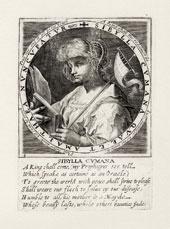 Prophecies of the Twelve Sybills |
By Gail Kern Paster
One important aspiration for the Folger’s milestone 75th birthday has been to acquire a rare book, manuscript or artwork that would add significantly to the library’s holdings in 16th- and 17th-century English materials. Such a signature acquisition would symbolize the Folger’s ongoing commitment to being “first and foremost a library,” as Henry Clay Folger, Class of 1879, stipulated—even as we move from strength to strength in our exhibitions, educational programs and award-winning performances.
The obstacles to making a signature acquisition are significant, the most obvious being the weakness of the dollar vis-à-vis the pound (since most dealers with whom we work are London-based) and the intense competition in the rare-book market. You may recall the recent sale at a Sotheby’s auction of a Shakespeare First Folio for more than $5 million.
We were thus thrilled to be offered the only known complete first edition of a small book, Prophecies of the Twelve Sybills, by Martin Droeshout. A London-born son of Dutch religious émigrés, Droeshout engraved the title page of the 1623 Shakespeare First Folio, giving to posterity the instantly recognizable face of Shakespeare—with high-domed forehead, Elizabethan ruff and 5 o’clock shadow—that everyone remembers.
Our wonderful new acquisition, dated 1620-25, features engravings by Droeshout of the classical sibyls (best known, perhaps, in Michelangelo’s rendering of them in the Sistine Chapel). Our book is a small, unassuming folio volume, made up of many little sheets folded in half. The engravings themselves are high in quality, with charming portraits of the 12 prophetesses wearing Renaissance garb and holding objects such as books, quill pens and bouquets. Beneath each portrait, a verse foretells the coming of Christ, which explains the full title of the book—The Prophecies of the Twelve Sybills Plainely foretelling the Incarnation, Birth, Life, Death and coming againe to Judgment of our Lord and Saviour Jesus Christ—and suggests how the role of ancient prophecy would have been understood in the Renaissance. (It was the Cumaean sibyl who, in Virgil’s Fourth Eclogue, foretells the coming of a great bringer of peace.)
The Folger is delighted to add to its 79 copies of the Shakespeare First Folio another important example of Martin Droeshout’s work as an engraver. And we are deeply indebted to Folger board member Paul T. Ruxin ’65 for generously supporting this acquisition.
Paster is director of the Folger Shakespeare Library in Washington, D.C. The Folger opened in 1932 with a gift from Henry Clay Folger, Class of 1879, and his wife, Emily, and is administered under the auspices of Amherst College.